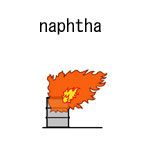| Case Name |
Fire caused due to leakage from a control valve flange, which became loose due to vibration at a catalytic reforming unit |
| Pictograph |

|
| Date |
October 4, 1987 |
| Place |
Sakai, Osaka, Japan |
| Location |
Refinery |
| Overview |
A fire occurred at the catalytic reforming unit of a petroleum refinery on October 4th, 1987. Bolts-tightening of the flange of the reaction control valve that caused the accident was slightly loose. The bolts loosened gradually because of vibration of piping during operating, and high-temperature gas including hydrogen leaked. The leaked gas made contact with the air, self-ignited, and fire occurred. The catalytic reforming unit was stopped urgently, and separation and interception from other plants were carried out. The fire was extinguished when internal pressure dropped to about 2 MPa. Tightening force management at hot-bolting work seemed to be insufficient. |
| Incident |
A fire occurred at the reaction control valve (RCV-227 in Fig2) of a catalytic reforming unit of a petroleum refinery operating as usual, and flame of about 50 cm high was generated. The catalytic reforming unit is a plant that manufactures aromatic hydrocarbon by cyclization and dehydrogenation of gas phase reaction with a catalyst. The condition of reaction is high temperature (450 °C or more), high-pressure (about 3 MPa), high hydrogen concentration (10 percent), and an environment where a leak occurs easily. (Temperature and pressure are an example of equipment that causes accidents, and when using the latest technology, pressure is much lower.) |
| Processing |
Manufacture |
| Individual Process |
Reaction |
| Process Flow |
Fig2.Unit process flow
|
| Chemical Reaction |
Other(cat-reforming) |
| Substance |
Naphtha |
| Type of Accident |
Leakage, fire |
| Sequence |
On October 4th, 1987 at about 08:40: A patrolling operator found a fire in the vicinity of the reaction control valve of the catalytic reforming unit. The central control room was informed by telephone from the operator. The sub leader on duty informed the fire station.
08:45: Emergency shutdown started. The fire of heating furnace was extinguished first, the raw material pump was stopped, and the catalytic reforming unit was separated and intercepted from other plants. Internal gas was ejected into the flare stack and was burnt. |
| Cause |
The tightening of 4 bolts out of 24 bolts, which tighten the flange of the reaction control valve, was loose. The bolts loosened gradually because of vibration of piping during operation, and high-temperature gas including hydrogen leaked. It is presumed the high-temperature leakage gas mixed with air and ignited spontaneously. |
| Response |
1. The operator on patrol found the fire and informed the central control room by site telephone. In addition, the sub leader on duty informed the fire station from the central control room.
2. Emergency shutdown of the catalytic reforming unit was done. Separation and interception from other plants were carried out, and the inside gas was discharged into the flare stack, and burned. The fire was extinguished itself due to pressure lowering in the system. |
| Countermeasures |
Hot-bolting instructions improved. |
| Knowledge Comment |
The tightening force of a bolt is decreased by expansion of bolt and piping in the high-temperature unit. Hot-bolting, which means tightening the bolt again according to temperature rise is done to maintain the tightening force of the bolt. Leakage accidents tend to occur if the range of hot-bolting, a frequency of hot-bolting, and the control of tightening force are incorrect. |
| Background |
It was speculated that there was a problem in maintenance management. There was a strong possibility that either the frequency of hot-bolting was the problem or the method of managing tightening force at hot-bolting, or both of them.
Hot-bolting: Re-tightening work to adjust expansion of the bolt in the high-temperature section. |
| Reason for Adding to DB |
Example of importance of operation standards and education |
| Scenario |
| Primary Scenario
|
Poor Value Perception, Poor Safety Awareness, Insufficient Safety Measure, Carelessness, Insufficient Precaution, Inadequate Handling, Usage, Maintenance/Repair, Hot-bolting, Bad Event, Mechanical Event, Loosend by Vibration, Secondary Damage, External Damage, Fire
|
|
| Sources |
High Pressure Gas Safety Inst. of Japan, High Pressure Gas Control Law and list of individual accidents list in 1987, High-pressure gas protection overview, pp.106-107(1988)
Japan assoc. for safety of hazardous materials, Naphtha gas that leaked from flange ignited by mixing with air, One hundred cases of accidents at dangerous facilities, pp.16-17(1991)
High Pressure Gas Safety Inst. of Japan, Catalytic reforming equipment, Leakage fire from remote control valve flange, Accident examples of petroleum refinery and Petrochemical units, pp.62-64(1995)
|
| Number of Injuries |
1 |
| Field |
Chemicals and Plants
|
| Author |
OGAWA, Terushige (Graduate School of Environment and Information Sciences, Yokohama National University)
TAMURA, Masamitsu (Center for Risk Management and Safety Sciences, Yokohama National University)
|
|